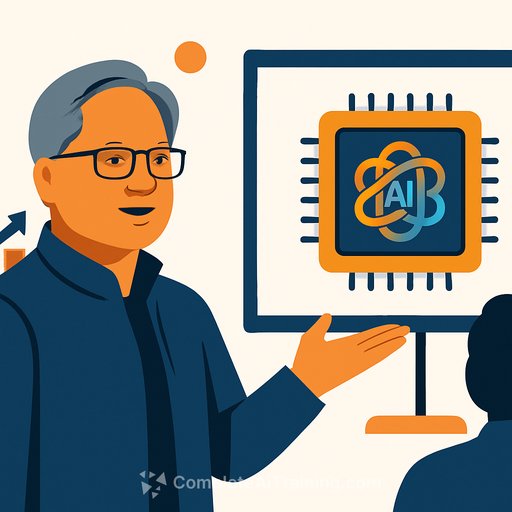NVDA News Today: Jensen Huang Unveils AI Chip Vision Amid Global Tech
Nvidia's CEO, Jensen Huang, outlined a next-wave AI chip vision that targets higher throughput with lower energy draw. The signal for executives: AI infrastructure strategy is moving toward performance-per-watt efficiency and broader deployment across industries.
The market reacted with interest, reinforcing Nvidia's role at the center of AI computing. This announcement sets expectations for new product cycles, ecosystem bets, and fresh software-hardware lock-in.
Jensen Huang's AI Chip Vision
The vision focuses on accelerating AI workloads while cutting power consumption across data center, edge, and device-level deployments. Faster training, cheaper inference, and lower TCO are the clear objectives.
For sectors like healthcare, automotive, and telecom, this points to more viable on-device and near-edge AI. Expect tighter integration of compute, networking, and software stacks to keep throughput predictable and costs controlled.
What This Means for Executives
- Plan for performance-per-watt: Recalculate TCO models with energy as a first-class constraint, not an afterthought.
- Prioritize inference economics: Shift procurement to SKUs and software stacks that reduce per-query cost at scale.
- Balance training vs. inference: Centralize training, push inference closer to users where latency matters.
- De-risk supply: Secure multi-vendor pathways for GPUs, networking, and memory to avoid allocation bottlenecks.
- Double down on software: Tooling and frameworks will drive utilization; underutilized hardware kills ROI.
- Talent and ops: Expand MLOps/SRE capabilities to maintain reliability as model sizes grow and workloads diversify.
Investor Sentiment and Market Context
The announcement coincided with a pickup in trading volumes and constructive sentiment as investors look for clarity on performance gains and margin impact. In the source content, NVDA shares are cited at $188.89, with investors watching for product timelines and revenue mix.
For ongoing price and volume data, see Yahoo Finance: NVDA. Execution against this vision will be measured by shipment cadence, customer adoption, and software attach.
Nvidia's Position in the Semiconductor Industry
Nvidia continues to operate from a position of scale, supported in the source content by a market cap of over $450B and a P/E of 53.15. That cash flow and market access enable sustained R&D and an expanding developer ecosystem.
Expect Nvidia to use this advantage to deepen integration across compute, networking, and AI software. For broader industry context, refer to CNBC: Nvidia coverage.
How to Pressure-Test the Strategy Internally
- Model energy and space constraints over a 24-36 month horizon; include cooling and power delivery upgrades.
- Benchmark inference at target latency/throughput with your actual model stack, not vendor demos.
- Run total system tests: accelerators, interconnects, memory bandwidth, and observability pipelines.
- Negotiate software value: prioritize support, optimization toolchains, and roadmap transparency.
- Stage-gate capex: phase purchases against workload growth and real utilization, not headlines.
What to Watch Next
- Product specifics: node, interconnect, memory bandwidth, and software optimizations for training vs. inference.
- Customer case studies: healthcare diagnostics, ADAS/AV stacks, and telco edge deployments.
- Supply signals: lead times, allocation dynamics, and availability across cloud and on-prem channels.
- Gross margin and mix: how new SKUs and software attach translate into profitability.
FAQs
What is Jensen Huang's AI chip vision about?
It targets faster AI processing with lower energy use across industries, reinforcing Nvidia's role in AI compute.
How does Nvidia maintain leadership in AI strategy?
By integrating hardware, networking, and software into deployable platforms for training and inference, backed by sustained R&D.
What impact does the AI chip vision have on Nvidia's stock?
It lifted optimism and trading interest in the source context. With a cited market cap above $450B, investors are watching execution details and margin effects.
Why is Nvidia important in semiconductors?
Consistent innovation, developer ecosystem depth, and financial scale position Nvidia favorably against peers for AI workloads.
How does Meyka assist investors?
Meyka provides real-time, AI-driven financial insights to track NVDA's performance and strategic moves.
Next Steps for Leaders
- Run a refreshed AI infra roadmap with energy targets, utilization goals, and inference cost thresholds.
- Pilot edge deployments where latency and bandwidth savings improve unit economics.
- Align procurement with measurable KPIs: throughput per watt, per-dollar, and per-rack-unit.
- Upskill teams on modern AI tooling and MLOps practices.
If your team needs a fast overview of practical AI training paths by role, explore AI courses by job.
Disclaimer: This content is for information only and not financial advice. Do your own research before making any investment decisions.
Your membership also unlocks:






